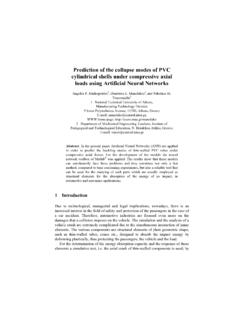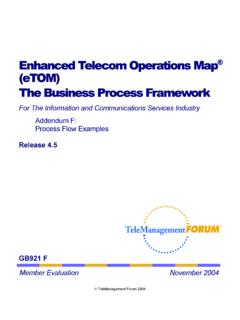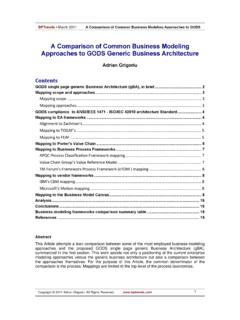Transcription of Ontology-Based Process Modeling Using eTOM and ITIL.
1 ERP Education in China: The Tale Of Two Paths 1001 Ontology-Based Process Modeling Using eTOM and ITIL Zhenning Shangguan, Zhipeng Gao and Kai Zhu State Key Laboratory of Networking and Switching Technology, Beijing University of Posts and Telecommunications, Beijing 100876, Abstract. With recently accelerated shifting trends from device-oriented to Process -oriented service management, large portions of business organizations are now on their way of adopting standards and best-practices such as the eTOM and the ITIL to model and manage their diverse business and operational processes. Although there are various Process /workflow definition formalisms to orchestrate these processes mentioned above, the rapid development and emerging demands for Process automation and interoperability requires systematic Modeling methodology and increased semantic information.
2 To achieve this goal, a comprehensive analysis about two commonly accepted Process frameworks the eTOM and the ITIL is presented in this paper first. Then, further studies concerning their mapping relationship and integrated application of these two Process frameworks are carried out, which forms the basis of our Process Modeling methodology. We also propose an Ontology-Based Process information model based on the preceding methodology, for the purpose of semantic richness. Finally, a novel and Ontology-Based business Process management architecture is given to provide an application scenario and thus, to demonstrate the correctness and feasibility of the proposal in this paper. Keywords: business Process Modeling , eTOM, ITIL, ontology , OWL-S 1.
3 INTRODUCTION Over the recent years, the IT/ICT (Information, Communication and Technology) industry has been tremendously facilitated by the rapid evolution and expansion of the converged data and network services provided by the global telecommunication infrastructure. At the same time, these IT/ICT service providers have also been confronted with the formidable challenges of how to configure, provide and manage their business processes in an efficient and customer-oriented fashion. Although the overall productivity and quality of the IT/ICT enterprises have generally increased over the past years, huge waves of complaints from the customer side seem never to diminish. It is still time-consuming to implement and put into practice new business processes or change existing business processes according to customer needs.
4 It seems that these companies always fail to keep pace with the rapid speed of emerging business changes. 1002 Zhenning Shangguan, Zhipeng Gao and Kai Zhu Clearly, there is a critical need for improvement. In fact, serious efforts concerning BPM ( business Process Management) from various parties, with the participation of international standardization organizations, academic institutions and consulting agents, etc., are now being carried out. Among all the contributions these parties have made, eTOM [1] and ITIL are two prevailing Process management frameworks which are widely accepted guidelines in their own industry. eTOM (Enhanced Telecom Operations Map) is part of the NGOSS (Next Generation Operational Support Systems) initiative proposed by the TMF (TeleManagement Forum).
5 ETOM is a comprehensive business Process framework to guide the development and management of key processes within any telecommunication service providers. It provides such guidance by offering a catalogue of standard terms and descriptions, with its scope spreads among multiple hierarchical levels. Since starting in 1999, eTOM has gradually added strategic, marketing, and product lifecycle planning and Enterprise Process elements. One of eTOM s objectives is to aid the end-to-end automation of business and operations processes by Using the eTOM Process framework for its entire value chain, including, for example, the service providers, customers, the software/hardware vendors, and system integrators.
6 ETOM has been adopted as ITU-T International Recommendation - known, in 2004, as ITIL (It Infrastructure Library) is the most well-known best practice and the de-facto standard of IT Service Management (ITSM) developed by the Central Computer and Telecommunication Agency (CCTA) of the Britain Government and then adopted and customized by many companies in the IT industry as their internal IT practice. Since its first publication in 1980 s, ITIL has gone through several minor restructuring and renaming which lead to the current ITIL Version 2. Among all of the topics covered in this new ITIL release, the most important content is the two core titles , namely Service Delivery and Service Support . The set of best practice guidelines and frameworks contained in ITIL will ensure quick delivery of reliable, consistent and of the highest quality.
7 In spite of all the endeavors mentioned above, service providers are now still facing with one critical dilemma: how to facilitate the integration and interoperability between heterogeneous industrial information environments [2]. Lessons from experience seem to indicate that the only way to overcome this difficulty is to express business Process knowledge in a global language that can be spoken and understood by all participants. Such kind of global language needs syntax, and semantics of concepts, relationships, constraints and support for reasoning based on existent models. This is exactly what an ontology provides. This paper presents a Modeling methodology which is essentially two-fold: combining eTOM and ITIL to analyze composite business processes, and then define these processes based on semantic web service ontologies.
8 For this purpose, the next section mainly describes the fundamental ideas of the proposed integrated Process Modeling methodology. A case study will also be given in this section to show the feasibility of our approach. Then, Ontology-Based Process Modeling technologies are studied. After that, the representation of the sample processes with the OWL-S service ontology is presented. Finally, some conclusions are summarized, followed by outlining of potential research topics. Ontology-Based Process Modeling Using eTOM and ITIL 1003 2. Process ANALYSIS: COMBINE eTOM AND ITIL High-level Comparison between eTOM and ITIL While both the eTOM and ITIL are Process frameworks, they are quite different in several aspects. As a standardized business Process framework proposed by TMF, whose major contributors are Telecos enterprises, eTOM lays much more emphasis on the efficient and guaranteed provision of end-to-end service.
9 This principle directly leads to the top-down hierarchical view of business processes, accompanied with detailed catalogue and descriptions of the compositional Process elements, within the whole enterprise. When it comes to ITIL, things are somewhat different. ITIL is not that specific in classifying and decomposing its processes into more granular units, while on the other hand, it only provides guidance, or sometimes advices, on the implementations of the IT Service Management. Combine eTOM and ITIL Process Frameworks In spite of the conspicuous distinctions, different terminologies, and essentially complementary nature of ITIL and eTOM, there are still large overlaps between them. It has been widely recognized that companies involved in both frameworks will benefit most from the combination of the two approaches.
10 Thus, recently there has been a heated discussion around the world about the integration of these two de-facto Process frameworks. In fact, TMF also provides officially a fundamental integration approach, by mapping ITIL on to an eTOM enabled Process environment [3]. Basically, the idea of this mapping is to illustrate how key ITIL scenarios (presently, only 3 scenarios in Change Management and Incident Management) are supported by eTOM elements. However, with no considerations on how to improve on the flow to ensure that it is fully compliant with the required ITIL Process , this mapping is at best illustrative. In practice, the analysis of the diverse business processes within an enterprise is all-consuming; therefore, an iterative methodology [4] is more favorable and efficacious to gain a streamlined and integrated business Process environment.










